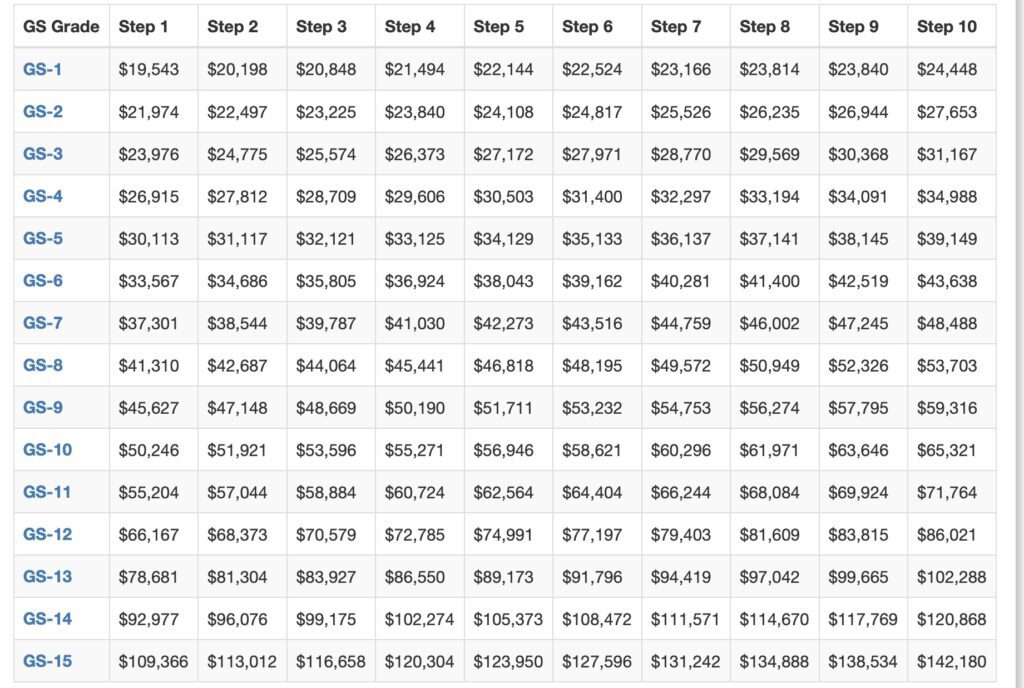The General Schedule is a pay scale for federal employees who work for the United States government in civil service roles. The General Schedule has 15 grades. The General Schedule begins with GS-1, which is the lowest grade, and ends with GS-15, the highest grade. Each grade has ten steps. Every step indicates a raise in salary. Each U.S. civil service determines which grade level is most appropriate for different jobs. Each position’s grade level is often determined by the job’s difficulty or other requirements.
| Grade levels | Requirements |
| GS-1 | No high school diploma required |
| GS-2 | High school diploma or equivalent |
| GS-3 | High school graduation or 1 year of full-time study after high school |
| GS-4 | Associate degree and 2 years of full-time study after high school |
| GS-5 | Bachelor’s degree and 4 years of full-time study after high school |
| GS-6 | Associate or Bachelor’s degree with one year experience at GS-5 or equivalent |
| GS-7 | Bachelor’s degree plus 1 year of full-time graduate study |
| GS-8 | Bachelor’s degree plus one year experience at GS-7 or equivalent |
| GS-9 | Master’s degree and 2 year of full-time graduate study |
| GS-10 | Master’s or equivalent graduate degree or 2 full years of higher graduate education leading towards a JD (standard understanding of the theories and concepts of U.S legal system) and a LLM (concentrated focus on a specific area of U.S law) |
| GS-11 | Ph.D or equivalent doctorate and advanced law degree (LL.M) |
| GS-12 | At least 1 year experience at GS-11 or equivalent. |
| GS-13 | Master’s or Ph. D. and at least 1 year experience at GS-12 or equivalent. |
| GS-14 | Have a minimum of one year of experience at the GS-13 level |
| GS-15 | At least 1 year experience at GS-13 or equivalent. |
Career Ladder Positions on the General Schedule
A career ladder is a position which has the potential for one to be promoted. You may start off as a GS-3 employee, but the career ladder may allow you to continue in this job and eventually make your way up to GS-10, thereby earning a higher position, pay, and benefits. If a position does not have an career ladder, it means that you will stay at that GS-# indefinitely.
| Grade levels | Positions Available |
| GS-3 or GS-4 | Typically internships or student jobs |
| GS-5 to GS-7 | Most entry-level positions |
| GS-8 to GS-12 | Mid-level positions |
| GS-13 to GS-15 | Top-level supervisory positions |
| Beyond GS-15 | Senior Executive Service |
Promotion Potential within the General Schedule
Promotion potential is a phrase used to describe the highest grade pay level for a job. Unlike many employers where employees compete with each other over promotions, employees can be promoted without having to compete against each other if their performance is considered acceptable. Promotion potential depends on the job and maximum attainable grade level for that job. For example, a position advertised at GS-13 with a top promotion level at 15 indicates that the highest the employee could attain is GS-15.
| Advancement From | Requires |
| Step 1 to Step 2 | 52 weeks of creditable service in Step 1 |
| Step 2 to Step 3 | 52 weeks of creditable service in Step 2 |
| Step 3 to Step 4 | 52 weeks of creditable service in Step 3 |
| Step 4 to Step 5 | 104 weeks of creditable service in Step 4 |
| Step 5 to Step 6 | 104 weeks of creditable service in Step 5 |
| Step 6 to Step 7 | 104 weeks of creditable service in Step 6 |
| Step 7 to Step 8 | 156 weeks of creditable service in Step 7 |
| Step 8 to Step 9 | 156 weeks of creditable service in Step 8 |
| Step 9 to Step 10 | 156 weeks of creditable service in Step 9 |
Benefits
Federal employees and their family members have access to many different benefits. Benefits ensure that the employee’s career and work life are balanced and give the employee an incentive to work for the government. However, benefits vary per agency. Benefits are also contingent on whether the employee’s position is full-time, intermittent, or part-time.
Compensation
- The federal government offers competitive and consistent base pay as compared to non-government entities.
- The federal government will help an employee repay up to $10,000 a year of his/her student loans for a lifetime cap of $60,000 in total loan repayment.
- Depending on the position and agency, the hiring agency may offer recruitment, retention, relocation, or performance incentives and awards. Some employers may even offer different incentive or award packages.
Leave and Workplace Flexibilities
- Employees are afforded vacation, personal, and sick time (otherwise known as “leave”). Employees can enjoy paid time off through the government’s different leave programs. Some employees accrue leave at a different rate than other federal employees. Some employees can qualify for a higher accrual rate. Employers sometimes consider the employee’s non-federal work or uniformed service experience.
- The federal government also offers alternative, non-traditional work schedules to allow employees to meet their personal needs.
- Federal agencies also encourage employees to telework when permitted. Telework allows employees to work from the comforts of their home or even overseas.
Dental and Vision Benefits
- Employees and their family members are able to be eligible for dental and vision insurance to be obtained on a competitive premium with no conditions that limits their insurance plan.
- In order for the employee’s family members to be eligible for the program, they must reach requirements such as being a spouse or unmarried dependent children that are under the age of 22.
- Employees must be eligible for the Federal Employee Dental and Vision Benefits (FEHB) program for this to happen
Health Insurance
- Employees or retirees family members are able to choose many of the health plans that are available for them which are Fee-for Service (FFS) plans, Preferred Provider Organization (PPO), and Health Maintenance Organizations (HMO).
- The FEHB plan brochure will show the retiree and employee the current services and supplies that are covered depending on the type of insurance plan they choose
Pay and Cost of Living Allowance on the General Schedule
Salaries are comprised of two parts: base pay and the locality pay adjustment. Base pay is the base amount of money an employee receives. Base pay may fluctuate depending on where the employee is located. For example, a GS-7 engineer living in Orange County, CA will have a higher base pay than a GS-7 engineer living in Detroit, MI due to the higher cost of living in Orange County, CA.
References
https://www.military.com/veteran-jobs/search/government-jobs/government-jobs-gs-codes-explained.html
https://gogovernment.org/pay-and-the-general-schedule-gs/
https://www.federalpay.org/gs/2019
https://www.opm.gov/policy-data-oversight/pay-leave/pay-systems/general-schedule/
https://www.usaid.gov/sites/default/files/documents/1868/418mad.pdf
Interested in joining the DME Interns team? Click here to find out more and sign up to be notified when applications open!




